A list of Chinese symbols, designs, and art motifs, including decorative ornaments, patterns, auspicious symbols, and iconography elements, used in Chinese visual arts, sorted in different theme categories. Chinese symbols and motifs are more than decorative designs as they also hold symbolic but hidden meanings which have been used and understood by the Chinese people for thousand of years; they often influenced by nature, which include the fauna, the flora, landscape, and clouds.[1][2] Chinese symbols often have auspicious meanings associated to them, such as good fortune, happiness, and also represent what would be considered as human virtues, such as filial piety, loyalty, and wisdom,[1] and can even convey the desires or wishes of the Chinese people to experience the good things in life.[2] There are also special symbols in Chinese arts, such as the qilin, and the Chinese dragon.[1] According to Chinese beliefs, being surrounding by objects which are decorated with such auspicious symbols and motifs was and continues to be believed to increase the likelihood that those wishes would be fulfilled even in present-day.[2] Chinese symbols and motifs are often found in Chinese decorative arts, porcelain ware, clothing, and personal adornments.[2]
Categorized sets or collections
- Chinese zodiac
- Eight Auspicious pattern (Bajixiang 八吉祥): The Eight Auspicious symbols of Buddhism
- Eight treasures (Babao 八寶)/ Eight precious things
- Flowers of the Four Seasons
- Four gentlemen
- Five Poisons
- Four symbols
- Twelve ornaments
Natural landscape and cosmology
Clouds, sun, stars, and moon
| Type | Name | Images | ||
|---|---|---|---|---|
| Clouds | Xiangyun / auspicious clouds | %252C_19th_century_(CH_18095597-2).jpg.webp) |
 | |
| Cosmic symbol | Yunjian (云肩)/ cloud collar motif | Persimon calyx | _(yunjian_motif).jpg.webp) |
_(yunjian).jpg.webp) |
Waves and sea
| Types | Name | Images |
|---|---|---|
| Composite | Haishuijiangya (海水江崖) | |
| Waves | Lang |  |
Animals
Mammals
| Name | Symbolism | Images | ||
|---|---|---|---|---|
| Bats | Bat (fu) | Homophone for good fortune and symbol for longevity and happiness.[3] | .jpg.webp) |
|
| Bats flying amongst clouds |  |
|||
| Bats with Chinese character "wan"(Swastika) | "Ten thousand-fold wishes for good fortune and happiness.”[3] | |||
| Five bats (wufu) | Wishes for the Five Blessings.[3] | 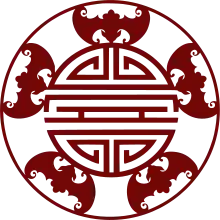 |
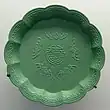 | |
| Red bats (hongfu) | Wide spread of good fortune[3] |  | ||
| Deer | Lü[4] |  |
||
| Elephant | Xiang | |||
| Horses | A horse | Speed and perseverance[5]: 37 | ||
| Eight horses | The 8 horses of King Mu of Zhou[5]: 37 | |||
| Tiger | ||||
Birds
Birds were symbols of literary refinement of the scholars with ability to fly towards the Heaven.[6]
| Name | Images | |
|---|---|---|
| Crane | A red-crowned crane[4] | |
| Magpie | ||
| Mandarin duck | A mandarin duck | |
| Pairs of mandarin duck | ||
Fish
| Types | Name | Symbolism | Images | ||
|---|---|---|---|---|---|
| Fish | Single fish | Yu (鱼, lit. "fish") | Wealth and abundance | .jpg.webp) |
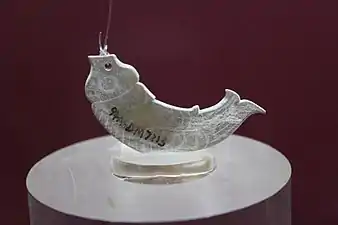 |
| Carp jumping at the Dragon Gate | Success in the civil service examinations[7]: 63 | 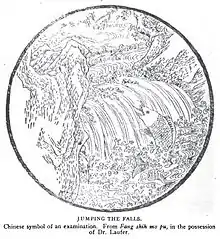 |
|||
| Double fish | Shuangyuwen (双鱼纹)/
Double fish[8]/ twin fish:[9] two horizontal fishes, each facing an opposite direction |
Marital happiness;[8] fertility and abundance[9] |  |
 | |
| Pairs of golden fish/ Golden fish (as part of the Eight Auspicious pattern):[8] two fishes in the vertical planes, with their faces inward.[3][10][11]: 84 [note 1] | Good fortune;[11]: 83 happiness;[10] freedom from restraint[3] |  |
|||
Insects
| Name | Description | Symbolism | Images | |
|---|---|---|---|---|
| Butterflies | Butterfly/ butterflies | A common motif used in Chinese embroidery and in Chinaware.[12] | The butterfly is a symbol of joy and summer.[12] It also implies long life, beauty and elegance.[6] | .jpg.webp) |
| Pair of butterflies | Pair of butterflies embroidered on clothing strengthens the energy of love.[6] | Love, especially young love; undying bond between lovers.[6] | ||
| Cicada | Cicada motifs were used as early as the Shang and Zhou dynasties to decorate bronze; both realistic and stylized cicada motif were used during these periods.[13]: 89 Cicada motifs were also used in 17th and 18th when decorating bronze and cloisonne objects which imitating ancient bronzes.[13]: 89 Jade carved in the shaped of a cicada used to be placed in the mouth the deceased before being buried.[12] It was believed that cicada jade would prevent the decaying of a corpse or speed up the deceased's rebirth.[13]: 89 | Symbol of immortality and resurrection (or regeneration[13]: 89 ); it is also a symbol of happiness and eternal youth as cicada's longevity is longer than other insects.[12] | 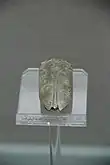 Cicada jade used in burial practice, Han dynasty | |
Imaginary animals
Chimeral animals
| Type | Name | Symbolism | Images | |||
|---|---|---|---|---|---|---|
| Chinese dragons[note 2] | C-shaped dragon/ Ring-like dragon | Hong (rainbow-dragon) | _3.jpg.webp) |
|||
| Hongshan Jade dragon | 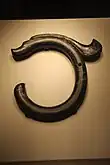 |
|||||
| Panlong[4] | 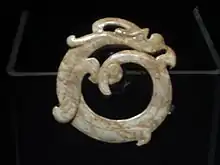 |
|||||
| Shuanglong[14] |  |
|||||
| Zhulong (Pig dragon) | ||||||
| Curly and coiled dragon | Azure dragon | |||||
| Kuilong (夔龙)[4] |  |
|||||
| Panchi[4] | ||||||
| Zisunlong (子孙龙) | ||||||
| Long dragon or mang dragon: 3-clawed dragons/ 4-clawed dragons, also called mang (蟒, lit. "python")/ 5-clawed dragons | Zhenglong (正龙)/ sitting dragon | 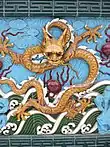 |
||||
| Lilong (立龙)/ standing dragon | 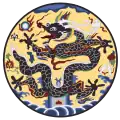 |
|||||
| Shenglong (升龙) / ascending dragon |  |
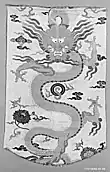 |
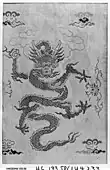 | |||
| Jianglong (降龙)/ descending dragon |  |
 |
||||
| Xinglong (行龙)/ travelling dragon | ||||||
| Dragon playing with pearl |  |
|||||
| Two dragon playing with flaming pearl/ pearl | .jpg.webp) |
|||||
 |
||||||
| Other 4-clawed dragons | Douniu | |||||
| Feiyu | ||||||
| Phoenix-like | Feng/huang | Single male (feng) or female phoenix (huang)[3] | Symbol of the empress of China.[3] |  |
||
| Fenghuang | Pair of phoenix (one male and one female)[3] | Marital happiness[3] | ||||
| Qilin | Male Qilin | Virtue and perfection[3] | ||||
| Female Qilin |  |
|||||
Bird-like creatures
| Types | Name | Symbolism | Image | ||
|---|---|---|---|---|---|
| Bird | Qingniao[15] | ||||
| Crow-like creatures | Jinwu (lit."golden crow")/ Yangwu | Erzuwu (二足金, lit."two-legged crow")/ Erzujinnian (二足金乌, lit "two-legged golden crow" | Sun | .JPG.webp) |
|
| Sanzuwu (三足烏, lit. "Three-legged crow ")[note 3] | .jpg.webp) |
||||
 |
|||||
| Sanzuwu (三足烏, lit. "Three-legged crow ") | .jpg.webp) |
||||
| Pheasant-like creatures | Vermillion bird | ||||
Animal-like creatures
| Types | Name | Symbolism | Images | ||
|---|---|---|---|---|---|
| Fox-like creatures | Hulijing (狐狸精)/ Fox spirit | Nine-tail fox | .jpg.webp) |
 | |
| Goat (or sheep)-like creature | Taotie | 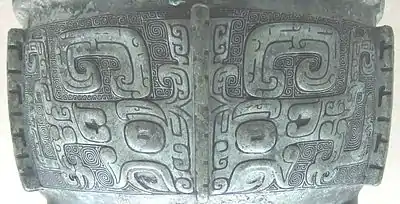 |
|||
| Xiezhi | Fairness, justice, and discrimination between the right and wrong.[16] | ||||
| Horse-like creatures | Haima[4] | ||||
| Lion-like creatures | Suan ni[4] | ||||
| Rabbit-like creature | Yu tu (玉兔, lit. 'Jade rabbit') / Yue tu (月兔, lit. 'Moon rabbit') | Jade rabbit in the moon disk | |||
| Jade rabbit pounding medicine/ elixir of life | .jpg.webp) |
||||
| Rabbits running amongst clouds | Moon.[17] |  |
|||
| Tiger-like creature | White tiger | ||||
| Toad-like (or frog-like) creature | Moon toad | toad on a moon crescent | .jpg.webp) |
||
| Dancing frog[15] | .jpg.webp) |
||||
| Three-legged toad | Jin Chan (Golden toad) | .jpg.webp) |
|||
| Jin Chan (Golden toad) biting a coin/ Money toad[18] | |||||
| Tortoise-like creature | Black tortoise | Xuanwu (玄武; also one of the Four Symbols) |  |
||
Composite
| Images | Name | ||
|---|---|---|---|
| Chinese dragon and fenghuang |  |
||
| Dragon turtle | Dragon turtle with carrying a small turtle on its back | ||
| Five poisons | _-_Scott_Semans.png.webp) |
||
| Moon rabbit and moon toad | .jpg.webp) |
||
Plants, flowers, and trees
Flowers
| Name | Symbol | Images | |
|---|---|---|---|
| Apricot | Apricot blossom[19] | ||
| Balsamine flower[19] | |||
| Chrysanthemum | Chrysanthemum flower | Symbol of autumn and longevity[3] | |
| Hibiscus | |||
| Lotus | Lotus flower[19] | ||
| Narcissus | |||
| Osmanthus | Osmanthus blossom[19] | ||
| Peach | Peach blossom[19] | Spring and happiness.[3] |  |
| Peony[19] | Peony flower | Associated with royalty.[3] It is also called “flower of rank and honour"; honours means attaining high rank, an official position or high social status.[3] | %252C_late_19th%E2%80%93early_20th_century_(CH_18148481-3)_(cropped).jpg.webp) |
| Plum | Plum flowers | Symbol of winter.[3] | |
| Pomegranate | Pomegranate flower[19] | ||
| Winter sweet | |||
Trees and plants
| Name | Images |
|---|---|
| Bamboo | %252C_late_19th%E2%80%93early_20th_century_(CH_18148481-3)_(cropped).jpg.webp) |
| Willow tree |
Composite
| Name | Description | Symbol | Images |
|---|---|---|---|
| Four gentlemen (si junzi) | Orchids, chrysanthemum, plum blossoms, and bamboo | Integrity and humility of the scholar.[3] | |
| Three friends of winter | Plum blossoms, bamboo, and pine | Longevity and resistance to the elements.[3] |
Fruits, vegetables, kernels, mushroom, and seeds
Fruits
| Name | Symbolism | Images | ||
|---|---|---|---|---|
| Gourd | Single gourd | Fertility[3] | ||
| Double gourd | Associated with deities and immortals[3] | |||
| Peaches | Peach fruit | Associated with the god Shoulao (god of longevity); symbol of a long life.[3] |  | |
| Peaches of immortality | Peach of immortality |  | ||
| Peach and Chinese character shou | 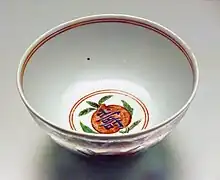 | |||
| Pomegranates | Pomegranate fruit | Whole pomegranate fruit | .jpg.webp) | |
Mushroom
| Name | Symbol | Images |
|---|---|---|
| Lingzhi | Immortality and shares the meaning of ruyi (如意), "as you wish".[3] | %252C_Yongzheng_re_-_Square_Covered_Box_with_Hundred_Antiquities_-_1989.309.a_-_Cleveland_Museum_of_Art.tif.jpg.webp) |
Inanimate objects
| Name | Symbolism | Images | ||
|---|---|---|---|---|
| Coins | Chinese numismatic charm | |||
| Gems/ Precious stone | Baozhu | Flaming pearl | .jpg.webp) | |
| Triratna/ triple gem | .jpeg.webp) | |||
| Hand-held fan | Open hand-held fan | .jpg.webp) | ||
| Ingot | Gold ingot |  | ||
| Silver ingot | ||||
| Knots | Endless knots | Infinite wisdom of Buddha[11]: 84 [note 4] | 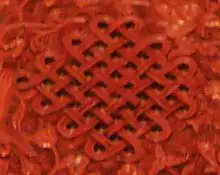 | |
Chinese characters
| Name | Symbolism | Images | |||
|---|---|---|---|---|---|
| Cai (wealth) | Stylized character | Wealth |  |
||
| Fo (佛) | Chinese character | Buddha | 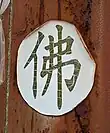 |
||
| Fu (福) | Chinese character | Upright | prosperity/ good luck | 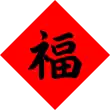 |
_Chinese_character).jpg.webp) |
| Upside down | 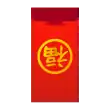 |
||||
| Stylized symbol | prosperity/ good luck | _Chinese_character.JPG.webp) |
|||
| Lu (禄) | Chinese character | 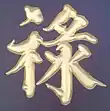 |
|||
| Stylized symbol |  |
||||
| Shou | Chinese character | longevity |  |
||
| Stylized symbol |  | ||||
| Shou with wan | .jpg.webp) |
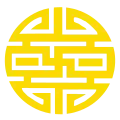 | |||
| Wan | Chinese character | Ten thousand years |  |
||
 |
|||||
| Xi (double happiness) | Chinese character | wedding bliss | 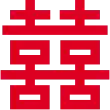 |
%252C_workshop_of_Tang_Wanheng_-_Mirror_with_Handle%252C_Decorated_with_%22Double_Happiness%22_and_Five_Bats_-_1995.401_-_Cleveland_Museum_of_Art.tif.jpg.webp) | |
| Stylized symbol |  |
||||
| Xi (happiness) | Chinese character | ||||
Composite |
Fushoushang (福壽双) | Chinese character | 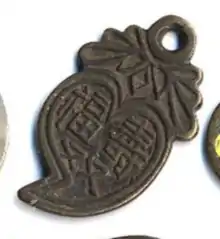 |
||
Taoist religion
Taoist deities and immortals
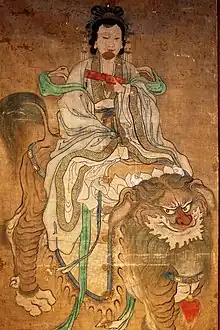
In present day China, the Sanxing and other Chinese folk deities continue to be perceived as powerful carrier of good fortune.[2] The Queen Mother of the West, Xi Wangmu, who is often figured in Chinese stories, is associated with symbols of longevity in Chinese arts as the peaches of immortality are believed to grow in her celestial peach orchard according to folklore stories.[20]
Taoist symbols
| Name | Images | ||
|---|---|---|---|
| Bagua | 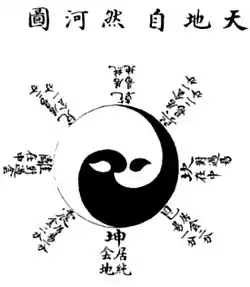 |
||
 |
|||
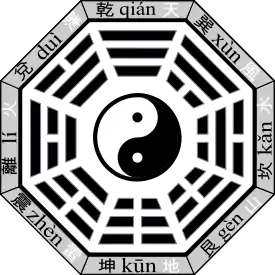 |
|||
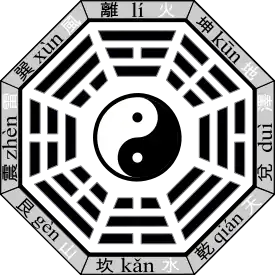 |
 | ||
| Hetu | 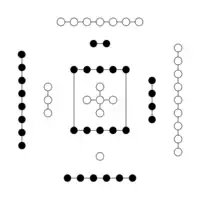 |
||
| Luoshu | 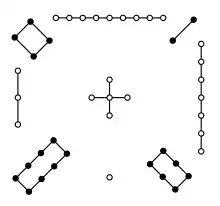 |
||
| Taiji | 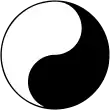 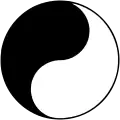 |
||
| Taijitu |  |
||
| Trigram figure | lí (離) |  |
|
| Wuji | 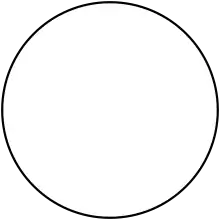 |
||
| Yin and Yang | 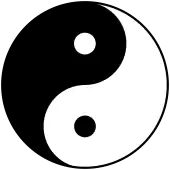 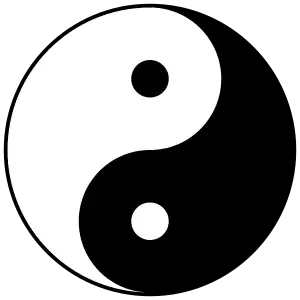 |
||
Buddhism religion
Buddhist entities
| Types | Name | Images | |
|---|---|---|---|
| Spirits | Female | Feitian (Apsara) | |
Borders/ meander, and repeated patterns
| Types | Name | Images | ||
|---|---|---|---|---|
| Chinese characters | Border | Gong (工; work) and bats | _02_(Gong_and_bat_decorative_border).jpg.webp) | |
| Decorative | Floral and twines | Grass pattern | Tang caowen[4] | |
| Twined branches | Chanzhiwen[4] | |||
| Curves | Pommel pattern | Guri (屈輪) /
Pommel scroll[21] |
_with_Sword-Pommel_Pattern_LACMA_M.87.203_(cropped).jpg.webp) | |
| Geometric | Diagonal | Diagonal straight lines | Lishui | 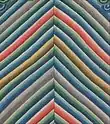 |
| Diagonal wavy lines | 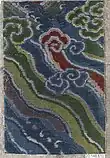 | |||
| Semicricles | Horizontal semi-circles | Woshui | ||
| Curvilinear | Swirl[4] |  | ||
| Wavy | Wavy | Boqu[4] | ||
| Others | Yunleiwen ( 云雷纹)/ Cloud-and-thunder pattern (meander) | Yunleiwen | ||
| Yunwen (云纹) / Cloud patterns (meander) | Yunwen | |||
| Leiwen (雷纹)/ Thunder patterns (meander) | Leiwen[4] | |||
| Composite | Floral and coin pattern | _-_Song_dynasty_-_Square_Mirror_with_Floral_and_Coin_Motifs_-_1995.371_-_Cleveland_Museum_of_Art.jpg.webp) | ||
Related concepts
See also
Notes
- ↑ When part of the Eight Auspicious pattern, both two fishes can either be upright (going upward) or be upside down (going downward).
- ↑ Depending on the time period, the Chinese dragons were depicted with 3, 4, or 5 claws. Since the Ming and Qing dynasties, it was established that the Chinese dragons (Long 龙) required 5-claws to meet their established definition of a Long (龙). Chinese dragons with less than 5 claws were no more considered as 'real' long (龙) dragons; e.g. the 4-clawed dragon then became known as mang (蟒, lit. "python").
- ↑ The crow in the sun disk is referred as sanzuwu when it is depicted with having three-legged
- ↑ When part of the Eight Auspicious pattern.
References
- 1 2 3 "Chinese Symbols – USC Pacific Asia Museum". pacificasiamuseum.usc.edu. Retrieved 2022-10-01.
- 1 2 3 4 5 "Hidden Meanings: Symbolism in Chinese Art from the collections of the Asian Art Museum of San Francisco Chong-Moon Lee Center for Asian Art and Culture | SFO Museum". www.sfomuseum.org. Retrieved 2022-10-01.
- 1 2 3 4 5 6 7 8 9 10 11 12 13 14 15 16 17 18 19 20 21 22 "Symbols – USC Pacific Asia Museum". pacificasiamuseum.usc.edu. Retrieved 2022-05-25.
- 1 2 3 4 5 6 7 8 9 10 11 12 "Chinese Patterns - Origin, History, Meaning, and Utilization | ChinaFetching". ChinaFetching.com. Retrieved 2022-05-24.
- 1 2 Buckhardt (2013). Chinese Creeds And Customs. Hoboken: Taylor and Francis. ISBN 978-1-136-22007-4. OCLC 862609536.
- 1 2 3 4 "Birds, Bats and Butterflies of Chinese Textiles | US-China Institute". china.usc.edu. Retrieved 2022-05-28.
- ↑ Eberhard, Wolfram (1986). A dictionary of Chinese symbols : hidden symbols in Chinese life and thought. London: Routledge & Kegan Paul. ISBN 0-7102-0191-5. OCLC 11970928.
- 1 2 3 "Pearls of Wisdom: The Arts of Islam at the University of Michigan | Bowl with Double Fish Motif". exhibitions.kelsey.lsa.umich.edu. Retrieved 2022-05-25.
- 1 2 "Dish with twin fish motif". www.roots.gov.sg. Retrieved 2022-05-25.
- 1 2 "The Golden Fishes - Tibetan Buddhist Encyclopedia". tibetanbuddhistencyclopedia.com. Retrieved 2022-05-25.
- 1 2 3 Keown, Damien (2003). A dictionary of Buddhism. [New York]: Oxford University Press. ISBN 978-0-19-172653-8. OCLC 52362166.
- 1 2 3 4 Williams, Charles (2006). Chinese symbolism and art motifs : a comprehensive handbook on symbolism in Chinese art through the ages. New York: Tuttle Pub. ISBN 978-1-4629-0314-6. OCLC 782879753.
- 1 2 3 4 Perkins, Dorothy (2013). Encyclopedia of China : History and Culture. Hoboken: Taylor and Francis. ISBN 978-1-135-93562-7. OCLC 869091722.
- ↑ Laufer, Berthold (1912-11-01). "Fish Symbols in China (Illustrated)". The Open Court. 1912 (11).
- 1 2 Theobald, Ulrich. "Xiwangmu 西王母, the Queen Mother of the West (www.chinaknowledge.de)". www.chinaknowledge.de. Retrieved 2022-05-25.
- ↑ Yang, Shuran; Yue, Li; Wang, Xiaogang (2021-08-01). "Study on the structure and virtual model of "xiezhi" gown in Ming dynasty". Journal of Physics: Conference Series. 1986 (1): 012116. Bibcode:2021JPhCS1986a2116Y. doi:10.1088/1742-6596/1986/1/012116. ISSN 1742-6588. S2CID 236985886.
- ↑ "Panel with Rabbits amid Clouds late 16th–early 17th century". www.metmuseum.org. Retrieved 2022-05-27.
- ↑ Yang, Shanshan (2016-01-01). "Frogs and toads in Chinese myths, legends, and folklore". Chinese America: History and Perspectives: 77–83.
- 1 2 3 4 5 6 7 "Chinese Flowers of Months and Cultural Meanings | ChinaFetching". ChinaFetching.com. Retrieved 2022-05-24.
- ↑ Denney, Joyce (2010). "Longevity in Chinese Art". www.metmuseum.org. Retrieved 2022-10-01.
- ↑ "Tray with pommel scrolls 14th century". www.metmuseum.org. Retrieved 2022-05-25.
Bibliography
- Eberhard, Wolfram (1986). A dictionary of Chinese symbols : hidden symbols in Chinese life and thought. London: Routledge & Kegan Paul. ISBN 978-0-203-03877-2. OCLC 826514710.
- Ren, Liqi (2013). Traditional Chinese visual design elements: their applicability in contemporary Chinese design (Master of Science in Design thesis). Arizona State University.
- Welch, Patricia Bjaaland (2012). Chinese art : a guide to motifs and visual imagery. Boston, US: Tuttle Publishing. ISBN 978-1-4629-0689-5. OCLC 893707208.
- Williams, Charles (2006). Chinese symbolism and art motifs : a comprehensive handbook on symbolism in Chinese art through the ages. New York: Tuttle Pub. ISBN 978-1-4629-0314-6. OCLC 782879753.